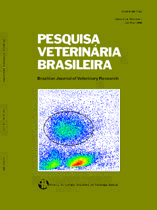 |
|
|
|
Year 2012 - Volume 32, Number 2
|

|
Occurrence and risk factors associated with the Corynebacterium pseudotuberculosis infection in sheep and goats from the semiarid region of the Paraiba state, Northeastern Brazil, 32(2):116-120
|
ABSTRACT.- Andrade J.S.L., Azevedo S.S., Teles J.A.A., Higino S.S.S. & Azevedo E.O. 2012. [Occurrence and risk factors associated with the Corynebacterium pseudotuberculosis infection in sheep and goats from the semiarid region of the Paraiba state, Northeastern Brazil.] Ocorrência e fatores de risco associados à infecção por Corynebacterium pseudotuberculosis em caprinos e ovinos do semiárido paraibano. Pesquisa Veterinária Brasileira 32(2):116-120. Unidade Acadêmica de Medicina Veterinária, Centro de Saúde e Tecnologia Rural, Universidade Federal de Campina Grande, Av. Universitária s/n, Patos, PB 58700-970, Brazil. E-mail: edisio@cstr.ufcg.edu.br
This study aimed to determine the occurrence and risk factors associated with Corynebacterium pseudotuberculosis infection in goats and sheep in semiarid region of Paraiba State, Northeastern Brazil. Of the 640 animals examined, 7.7% (49/640) had clinical evidence of caseous lymphadenitis. In 59.2% (29/49) of these animals there was only the scars of previously ruptured abscesses and in 40.8% (20/49) of the animals abscesses were intact. Of these 20 animals 13 (65%) goats had 14 abscesses, whereas seven (35%) sheep had eight abscesses. In both species, pre-scapular lymph node was the most involved. C. pseudotuberculosis was the agent most frequently isolated, in 15 (68.2%) samples, and in one (4.5%) coagulase-negative Staphylococcus was isolated, one (4.5%) Enterococcus sp., one (4.5%) Proteus mirabilis and Pseudomonas aeruginosa, and in four (18.2%) samples there was no bacterial growth. The final logistic regression model showed that animals from herds where their owners let the abscesses break naturally presented larger odds of caseous lymphadenitis (odds ratio = 8.19, 95% CI = 1.75 - 38.25, p = 0.008). We conclude that goat/sheep owners of the region should adopt preventive measures in their herds, such as early opening and drainage of superficial abscesses, and appropriate destination of the content. Such measures, in addition to regular inspection of the flock, disposal of diseased animals and introduction of non-infected animals will contribute to the control of this infection. |
| |
|
|
| |
|
 |